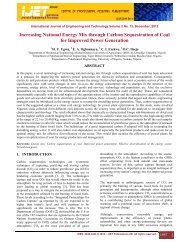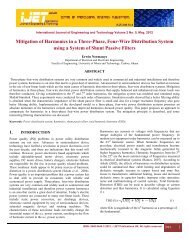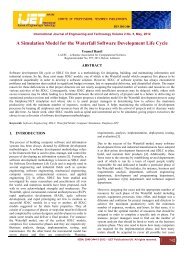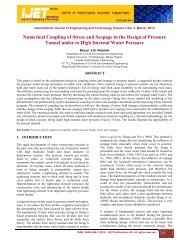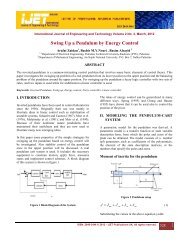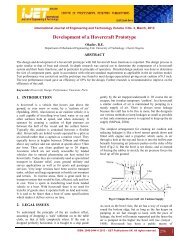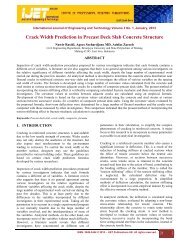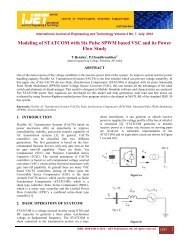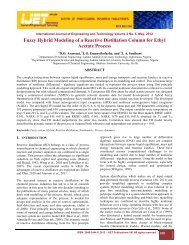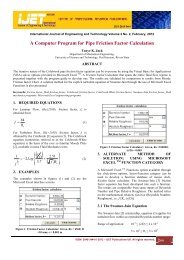Investigations on Three Phase Five Level Flying Capacitor Multilevel ...
Investigations on Three Phase Five Level Flying Capacitor Multilevel ...
Investigations on Three Phase Five Level Flying Capacitor Multilevel ...
You also want an ePaper? Increase the reach of your titles
YUMPU automatically turns print PDFs into web optimized ePapers that Google loves.
Internati<strong>on</strong>al Journal of Engineering and Technology Volume 2 No. 7, July, 2012<br />
<str<strong>on</strong>g>Investigati<strong>on</strong>s</str<strong>on</strong>g> <strong>on</strong> <strong>Three</strong> <strong>Phase</strong> <strong>Five</strong> <strong>Level</strong> <strong>Flying</strong><br />
<strong>Capacitor</strong> <strong>Multilevel</strong> Inverter<br />
C.R.Balamurugan 1 , S.P.Natarajan 2 ,R.Bensraj 3<br />
1 Department of EEE, Arunai Engineering College,Tiruvannamalai, Tamilnadu, India<br />
2 Department of EIE, Annamalai University, Chidambaram, Tamilnadu, India<br />
3 Department of EEE, Annamalai University,Chidambaram, Tamilnadu, India<br />
ABSTRACT<br />
The use of multilevel inverters is widespread in medium voltage applicati<strong>on</strong>s due to their inherent voltage sharing am<strong>on</strong>g the<br />
devices. This work proposes three phase five level <strong>Flying</strong> <strong>Capacitor</strong> <strong>Multilevel</strong> Inverter (FCMLI) using various modulating<br />
techniques for inducti<strong>on</strong> motor load. These Pulse Width Modulating (PWM) techniques include Carrier Overlapping (CO)<br />
strategy, Variable Frequency (VF) strategy, <strong>Phase</strong> Shift (PS) strategy and Sub-Harm<strong>on</strong>ic Pulse Width Modulati<strong>on</strong> (SHPWM)<br />
i.e. <strong>Phase</strong> Dispositi<strong>on</strong> (PD) strategy, <strong>Phase</strong> Oppositi<strong>on</strong> Dispositi<strong>on</strong> (POD) strategy and Alternate <strong>Phase</strong> Oppositi<strong>on</strong><br />
Dispositi<strong>on</strong> (APOD) strategy. The Total Harm<strong>on</strong>ic Distorti<strong>on</strong> (THD), V RMS (fundamental), crest factor, form factor and<br />
distorti<strong>on</strong> factor are evaluated for various modulati<strong>on</strong> indices. Simulati<strong>on</strong> is performed using MATLAB-SIMULINK. It is<br />
observed that PODPWM method provides output with relatively low distorti<strong>on</strong>. COPWM is also found to perform better<br />
since it provides relatively higher fundamental RMS output voltage for Inducti<strong>on</strong> Motor (IM) load.<br />
Keywords: CF, FCMLI, FF, PWM , THD, V rms<br />
LIST OF ABBREVATIONS<br />
CF<br />
Crest Factor<br />
THD<br />
Total Harm<strong>on</strong>ic Distorti<strong>on</strong><br />
FF<br />
Form Factor<br />
PD<br />
<strong>Phase</strong> Dispositi<strong>on</strong><br />
POD<br />
<strong>Phase</strong> Oppositi<strong>on</strong> and Dispositi<strong>on</strong><br />
APOD Alternate <strong>Phase</strong> Oppositi<strong>on</strong> and Dispositi<strong>on</strong><br />
VF<br />
Variable Frequency<br />
PS<br />
<strong>Phase</strong> Shift<br />
FCMLI <strong>Flying</strong> <strong>Capacitor</strong> <strong>Multilevel</strong> Inverter<br />
SHPWM Sub Harm<strong>on</strong>ic Pulse Width Modulati<strong>on</strong><br />
NC<br />
No C<strong>on</strong>necti<strong>on</strong><br />
IM<br />
Inducti<strong>on</strong> Motor<br />
A c<br />
Amplitude of the Carrier<br />
A m<br />
Amplitude of the Reference<br />
f m<br />
Frequency of the Modulating Signal<br />
f c<br />
Frequency of the Carrier Signal<br />
m<br />
Number of <strong>Level</strong>s<br />
m a<br />
Amplitude Modulati<strong>on</strong> index<br />
m f<br />
Frequency Modulati<strong>on</strong> index<br />
<strong>Phase</strong> Voltage<br />
V an<br />
1. INTRODUCTION<br />
<strong>Multilevel</strong> inverters offer a number od advantages when<br />
compared to the c<strong>on</strong>venti<strong>on</strong>al two level inverter. The<br />
recent development of new power semic<strong>on</strong>ductor<br />
technologies capable of handling higher voltage and<br />
current ratings has helped the c<strong>on</strong>solidati<strong>on</strong> of multilevel<br />
topologies in medium voltage drives. Janyavula and<br />
Saxena [1] made a detailed study <strong>on</strong> diode clamped<br />
multilevel inverter with respect to modulati<strong>on</strong> index and<br />
c<strong>on</strong>trol strategy. Urmila and Subbarayudu [2] also made a<br />
detailed study <strong>on</strong> pulse width modulati<strong>on</strong> techniques.<br />
Natchp<strong>on</strong>g et al [3] proposed a 6.6 KV transformer less<br />
motor drive using five level diode clamped inverter for<br />
ISSN: 2049-3444 © 2012 – IJET Publicati<strong>on</strong>s UK. All rights reserved. 1131
Internati<strong>on</strong>al Journal of Engineering and Technology (IJET) – Volume 2 No. 7, July, 2012<br />
energy saving pumps and blowers. Trabelsi and Brahim<br />
[4] developed a power c<strong>on</strong>diti<strong>on</strong>ing system based <strong>on</strong><br />
flying capacitor inverter. Zhang and Sun [5] introduced an<br />
efficient c<strong>on</strong>trol strategy for a five level inverter<br />
comprising flying capacitor asymmetrical H-bridge.<br />
Mailah et al [6] described in detail simulati<strong>on</strong> and<br />
c<strong>on</strong>structi<strong>on</strong> of single phase flying capacitor multilevel<br />
inveter. Shanthi and Natarajan [7] made a comparative<br />
study <strong>on</strong> carrier overlapping PWM strategies for five level<br />
flying capacitor inverter. Huang and Corzine [8] proposed<br />
extended operati<strong>on</strong> of flying capacitor multilevel<br />
inverters. Lai and Peng [9] made a survey <strong>on</strong> topologies,<br />
c<strong>on</strong>trols and applicati<strong>on</strong>s in multilevel inverter. Kang et<br />
al [10] developed a symmetric carrier technique of<br />
CRPWM for voltage balance method of flying capacitor<br />
multilevel inverter. Kim et al [11] developed a<br />
generalized Undeland snubber for flying capacitor<br />
multilevel inverter and c<strong>on</strong>verter. Mcgrath and Holmes<br />
[12] developed sinusoidal PWM of multilevel inverter in<br />
the over modulati<strong>on</strong> regi<strong>on</strong>. This literature survey reveals<br />
few papers <strong>on</strong>ly <strong>on</strong> various PWM techniques and hence<br />
this work presents a novel approach for c<strong>on</strong>trolling the<br />
harm<strong>on</strong>ics of output voltage of chosen MLI fed IM<br />
employing sinusoidal switching strategies. Simulati<strong>on</strong>s<br />
are performed using MATLAB-SIMULINK. Harm<strong>on</strong>ics<br />
analysis and evaluati<strong>on</strong> of performance measures for<br />
various modulati<strong>on</strong> indices have been carried out and<br />
presented.<br />
levels are shown in Table 1 where ‘+’ denotes charging<br />
and ‘–’ denotes discharging of capacitors while NC<br />
indicates neither charging nor discharging. Chosen<br />
FCMLI is simulated using MATLAB-SIMULINK.<br />
Figure 1: A three phase five level FCMLI<br />
2. MULTILEVEL INVERTER<br />
<strong>Multilevel</strong> inverter is an effective and practical soluti<strong>on</strong><br />
for reducing switching losses in high power inverters.<br />
<strong>Multilevel</strong> inverter c<strong>on</strong>cept involves utilizing a higher<br />
number of active semic<strong>on</strong>ductor switches to perform the<br />
power c<strong>on</strong>versi<strong>on</strong> in small voltage steps for getting higher<br />
output voltage and reducti<strong>on</strong> in harm<strong>on</strong>ic distorti<strong>on</strong>. Such<br />
multilevel inverter topology permits a significant<br />
reducti<strong>on</strong> of the output filter and an improvement of the<br />
efficiency greater than 98% for loads greater than 40% of<br />
its rated output power. FCMLI is a multiple voltage level<br />
inverter topology which uses capacitors (called flying<br />
capacitors) for clamping the voltage across the power<br />
semic<strong>on</strong>ductor devices. One phase of three phase m level<br />
FCMLI requires 2(m-1) semic<strong>on</strong>ductor switches. The five<br />
level FCMLI c<strong>on</strong>sists of four switching pairs (S A1 S A1 ’),<br />
(S A2 S A2 ’), (S A3 S A3 ’) and (S A4 S A4 ’). If <strong>on</strong>e switch of the<br />
pair is switched ON, the other complementary switch of<br />
same pair must be OFF. The switches are clamped by DClink<br />
together with flying capacitors. The four switches<br />
(S A1 to S A4 ) must be c<strong>on</strong>nected in series between DC<br />
input and load and likewise for (S A1 ’to S A4 ’). The three<br />
flying capacitors C A1 , C A2 and C A3 are charged to different<br />
voltage levels. By changing the transistor switching states,<br />
the capacitors and the DC source are c<strong>on</strong>nected in<br />
different ways to produce various load voltages. Typical<br />
switch combinati<strong>on</strong>s for obtaining different output voltage<br />
Figure 2: Sample PWM generati<strong>on</strong> logic developed for<br />
PDPWM technique using SIMULINK<br />
ISSN: 2049-3444 © 2012 – IJET Publicati<strong>on</strong>s UK. All rights reserved. 1132
Internati<strong>on</strong>al Journal of Engineering and Technology (IJET) – Volume 2 No. 7, July, 2012<br />
The steps to synthesis the five level phase a output<br />
voltage in this work are as follows:<br />
a. For phase a output voltage of V AN =0, two upper<br />
switches S A3 , S A4 and two lower switches S A1 ’ and<br />
S A2 ’ are turned <strong>on</strong>.<br />
b. For an output voltage of V AN =V dc /4, three upper<br />
switches S A1 , S A2 , S A3 and <strong>on</strong>e lower switch S A4 ’ are<br />
turned <strong>on</strong>.<br />
c. For an output voltage of V AN =V dc /2, all upper<br />
switches S A1 through S A4 are turned <strong>on</strong>.<br />
d. To obtain the output voltage of V AN = -V dc /4, upper<br />
switch S A1 and three lower switches S A2 ’, S A3 ’ and<br />
S A4 ’ are turned <strong>on</strong>.<br />
e. For an output voltage of V AN = -V dc /2, all lower<br />
switches S A1 ’ through S A4 ’ are turned <strong>on</strong>.<br />
The phase a output voltage V AN has five states: Vdc/2,<br />
Vdc/4, 0, - Vdc/4 and - Vdc/2. The gate signals for the<br />
chosen five level FCMLI are developed using MATLAB-<br />
SIMULINK. The gate signal generator model developed<br />
is tested for various values of modulati<strong>on</strong> index. The<br />
results of the simulati<strong>on</strong> study are presented in this work<br />
in the form of the PWM outputs of the chosen multilevel<br />
inverter.<br />
Table 1: Switching scheme for <strong>on</strong>e phase of three<br />
phase five level FCMLI<br />
S A1 S A2 S A3 S A4 C A3 C A4 C A5 V AN<br />
1 1 1 1 NC NC NC +V dc /2<br />
1 1 1 0 NC NC +<br />
1 1 0 1 NC + -<br />
1 0 1 1 + - NC<br />
0 1 1 1 - NC NC<br />
0 0 1 1 NC - NC<br />
0 1 0 1 - + -<br />
0 1 1 0 - NC +<br />
1 0 0 1 + NC -<br />
1 0 1 0 + - +<br />
1 1 0 0 NC + NC<br />
1 0 0 0 + NC NC<br />
0 1 0 0 - + NC<br />
0 0 1 0 NC - +<br />
0 0 0 1 NC NC -<br />
+V dc /4<br />
0<br />
-V dc /4<br />
0 0 0 0 NC NC NC -V dc /2<br />
3. MULTI CARRIER BASED PWM<br />
METHODS<br />
This work used the intersecti<strong>on</strong> of a sine wave with a<br />
triangular wave to generate firing pulses for a five level<br />
inverter. There are many alternative strategies to<br />
implement this. They are as given below.<br />
a. <strong>Phase</strong> dispositi<strong>on</strong> PWM strategy.<br />
b. <strong>Phase</strong> oppositi<strong>on</strong> dispositi<strong>on</strong> PWM strategy.<br />
c. Alternate phase oppositi<strong>on</strong> dispositi<strong>on</strong> PWM<br />
strategy.<br />
d. Carrier overlapping PWM strategy.<br />
e. Variable frequency PWM strategy.<br />
f. <strong>Phase</strong> shift PWM strategy.<br />
3.1 <strong>Phase</strong> Dispositi<strong>on</strong> PWM Strategy<br />
The rules for phase dispositi<strong>on</strong> method (Fig.3) for chosen<br />
five level inverter are<br />
a. 4 carrier waveforms in phase are arranged.<br />
b. The c<strong>on</strong>verter is switched to + Vdc/2 when the sine<br />
wave is greater than both upper carriers.<br />
c. The c<strong>on</strong>verter is switched to + Vdc/4 when the sine<br />
wave is greater than first upper carrier.<br />
d. The c<strong>on</strong>verter is switched to zero when sine wave is<br />
lower than upper carrier but higher than the lower<br />
carrier.<br />
e. The c<strong>on</strong>verter is switched to – Vdc/4 when the sine<br />
wave is less than first lower carrier.<br />
f. The c<strong>on</strong>verter is switched to - Vdc/2 when the sine<br />
wave is less than both lower carriers.<br />
The following formula is applicable to sub harm<strong>on</strong>ic<br />
PWM strategy i.e. PD, POD and APOD<br />
The frequency modulati<strong>on</strong> index<br />
f<br />
c<br />
m= a<br />
f m<br />
The amplitude modulati<strong>on</strong> index<br />
ISSN: 2049-3444 © 2012 – IJET Publicati<strong>on</strong>s UK. All rights reserved. 1133
Internati<strong>on</strong>al Journal of Engineering and Technology (IJET) – Volume 2 No. 7, July, 2012<br />
2A<br />
m<br />
m= a<br />
(m-1)A c<br />
where<br />
f c – Frequency of the carrier signal<br />
f m – Frequency of the reference signal<br />
A m –Amplitude of the reference signal<br />
A c – Amplitude of the carrier signal<br />
m – number of levels.<br />
Carriers are arranged in such a manner that each carrier is<br />
out of phase with its neighbor by 180 degrees (Fig.5).<br />
In this paper, m f = 40 and ma is varied from 0.6 to 1. m f is<br />
chosen as 40 as a trade off in view of the following<br />
reas<strong>on</strong>s:<br />
a. to reduce switching losses (which may be high at<br />
large m f )<br />
b. to reduce the size of the filter needed for the closed<br />
loop c<strong>on</strong>trol, the filter size being moderate at<br />
moderate frequencies<br />
c. to effectively utilise the available dSPACE system<br />
for hardware implementati<strong>on</strong>.<br />
Figure 5: Carrier arrangement for APODPWM strategy<br />
(m a =0.8 and m f =40)<br />
3.4 <strong>Phase</strong> Shift PWM (PSPWM) Strategy<br />
The phase shift multicarrier PWM technique (Fig.6) uses<br />
four carrier signals of the same amplitude and frequency<br />
which are shifted by 90 degrees to <strong>on</strong>e another to generate<br />
the five level inverter output voltage. The gate signals for<br />
the chosen inverter can be derived directly from the PWM<br />
signals (comparis<strong>on</strong> of the carrier with the sinusoidal<br />
reference).<br />
Am<br />
m= a<br />
A c /2<br />
Figure 3: Carrier arrangement for PDPWM strategy<br />
(m a =0.8 and m f =40)<br />
3.2 <strong>Phase</strong> Oppositi<strong>on</strong> Dispositi<strong>on</strong> Strategy<br />
Four carrier waveforms are arranged so that all carrier<br />
waveforms above zero are in phase and they are 180<br />
degrees out of phase with those below zero (Fig.4)<br />
Figure 8: Carrier arrangement for VFPWM strategy<br />
(m a =0.8 , m f =40(Upper and Lower Switches) and<br />
m f =80(Intermediate Switches))<br />
4. SIMULATION RESULTS<br />
Figure 4: Carrier arrangement for PODPWM strategy<br />
(m a =0.8 and m f =40)<br />
3.3 Alternative <strong>Phase</strong> Oppositi<strong>on</strong> and<br />
Dispositi<strong>on</strong> (APOD) Strategy<br />
The three phase flying capacitor five level inverter is<br />
modeled in SIMULINK using power system block set.<br />
Simulati<strong>on</strong>s are performed for different values of m a<br />
ranging from 0.6 to 1 and the corresp<strong>on</strong>ding %THD are<br />
measured using the FFT block and their values are shown<br />
in Table 2. Figs. 9 – 26 show the simulated output<br />
voltages of FCMLI fed IM and their harm<strong>on</strong>ic spectra,<br />
speed and torque characteristics of Inducti<strong>on</strong> Motor (IM)<br />
with above strategies but for <strong>on</strong>ly <strong>on</strong>e sample value of m a<br />
= 0.8. Fig. 10 shows the five level output voltage<br />
ISSN: 2049-3444 © 2012 – IJET Publicati<strong>on</strong>s UK. All rights reserved. 1134
Internati<strong>on</strong>al Journal of Engineering and Technology (IJET) – Volume 2 No. 7, July, 2012<br />
generated by PDPWM strategy and its FFT plot is shown<br />
in Fig. 11. From Fig. 11, it is observed that the PDPWM<br />
strategy produces significant 30 th , 32 nd , 37 th and 39 th<br />
harm<strong>on</strong>ic energy. Fig 13 shows the five level output<br />
voltage generated by PODPWM strategy and its FFT plot<br />
is shown in Fig. 14. From Fig. 14, it is observed that the<br />
PODPWM strategy produces significant 33 rd and 35 th<br />
harm<strong>on</strong>ic energy. Fig 16 shows the five level output<br />
voltage generated by APODPWM strategy and its FFT<br />
plot is shown in Fig. 17. From Fig. 17, it is observed that<br />
the APODPWM strategy produces significant 35 th and<br />
37 th harm<strong>on</strong>ic energy. Fig 19 shows the five level output<br />
voltage generated by COPWM strategy and its FFT plot is<br />
shown in Fig. 20. From Fig. 20, it is observed that the<br />
COPWM strategy produces significant 3 rd , 4 th , 5 th , 6 th ,<br />
34 th , 35 th , 36 th , 37 th and 38 th harm<strong>on</strong>ic energy. Fig 22<br />
shows the five level output voltage generated by VFPWM<br />
strategy and its FFT plot is shown in Fig. 23. From Fig.<br />
23, it is observed that the VFPWM strategy produces<br />
significant 34 th and 38 th harm<strong>on</strong>ic energy. Fig 25 shows<br />
the five level output voltage generated by PSPWM<br />
strategy and its FFT plot is shown in Fig. 26. From Fig.<br />
26, it is observed that the PSPWM strategy produces no<br />
significant harm<strong>on</strong>ic energy. Figs. 9, 12, 15, 18, 21, 24<br />
show speed torque characteristics of chosen MLI fed IM<br />
for various PWM strategies. The following parameter<br />
values are used for simulati<strong>on</strong> : V dc = 440V , inducti<strong>on</strong><br />
motor load – 50HP(37 KW), 400V, 50Hz, 1480rpm, T m =<br />
4Nm, f c = 2000Hz, f m = 50Hz.<br />
Figure 11: FFT plot for output voltage of PDPWM strategy<br />
for IM load<br />
Figure 12: Speed and torque characteristics of IM for<br />
PODPWM strategy<br />
Figure 9: Speed and torque characteristics of IM for<br />
PDPWM strategy<br />
Figure 13: Output voltage generated by PODPWM strategy<br />
for IM load<br />
Figure 10: Output voltage generated by PDPWM strategy<br />
for IM load<br />
ISSN: 2049-3444 © 2012 – IJET Publicati<strong>on</strong>s UK. All rights reserved. 1135
Internati<strong>on</strong>al Journal of Engineering and Technology (IJET) – Volume 2 No. 7, July, 2012<br />
Figure 14: FFT plot for output voltage of PODPWM<br />
strategy for IM load<br />
Figure 17: FFT plot for output voltage of APODPWM<br />
strategy for IM load<br />
Figure 15: Speed and torque characteristics of IM for<br />
APODPWM strategy<br />
Figure 18: Speed and torque characteristics of IM for<br />
COPWM strategy<br />
Figure 16: Output voltage generated by APODPWM<br />
strategy for IM load<br />
Figure 19: Output voltage generated by COPWM strategy<br />
for IM load<br />
ISSN: 2049-3444 © 2012 – IJET Publicati<strong>on</strong>s UK. All rights reserved. 1136
Internati<strong>on</strong>al Journal of Engineering and Technology (IJET) – Volume 2 No. 7, July, 2012<br />
Figure 20: FFT plot for output voltage of COPWM strategy<br />
for IM load<br />
Figure 23: FFT plot for output voltage of VFPWM strategy<br />
for IM load<br />
Figure 21: Speed and torque characteristics of IM for<br />
VFPWM strategy<br />
Figure 24: Speed and torque characteristics of IM for<br />
PSPWM strategy<br />
Figure 22: Output voltage generated by VFPWM strategy<br />
for IM load<br />
Figure 25: Output voltage generated by PSPWM strategy<br />
for IM load<br />
ISSN: 2049-3444 © 2012 – IJET Publicati<strong>on</strong>s UK. All rights reserved. 1137
Internati<strong>on</strong>al Journal of Engineering and Technology (IJET) – Volume 2 No. 7, July, 2012<br />
5. CONCLUSION<br />
In this work the simulati<strong>on</strong> results of three phase five<br />
level flying capacitor multilevel inverter fed inducti<strong>on</strong><br />
motor load with various modulating strategies are<br />
obtained through MATLAB/SIMULINK. The output<br />
quantities like phase voltage, THD spectrum for phase<br />
voltage, and torque-speed characteristics of inducti<strong>on</strong><br />
motor are obtained. It is observed from Table 2 that<br />
PODPWM method provides output with relatively low<br />
distorti<strong>on</strong>. COPWM is also found to perform better<br />
(Table 3) since it provides relatively higher fundamental<br />
RMS output voltage. Table 4 and 5 show the crest factor<br />
and form factor.<br />
Figure 26: FFT plot for output voltage of PSPWM strategy<br />
for IM load<br />
Table 2: % THD comparis<strong>on</strong> for different modulati<strong>on</strong><br />
indices for IM load<br />
m a PD POD APOD CO PS VF<br />
1 27.63 27.32 28.13 32.65 28.14 27.66<br />
0.9 34.44 34.31 34.85 39.18 34.09 34.29<br />
0.8 39.34 39.10 39.57 45.92 39.8 39.28<br />
0.7 43.08 42.93 43.16 55.7 43.02 43.5<br />
0.6 45.39 45.32 45.32 66.8 45.95 45.44<br />
Table 3: VRMS (fundamental) for different modulati<strong>on</strong><br />
indices for IM load<br />
m a PD POD APOD CO PS VF<br />
1 154.5 154.8 154.3 157.6 154.2 154.5<br />
0.9 138.8 138.8 138.6 143.8 138.4 138.8<br />
0.8 123 123.1 123 128.7 122.1 123.1<br />
0.7 107.2 106.9 107.2 110.4 106.9 106.9<br />
0.6 91.6 91.45 91.65 91.07 90.14 91.8<br />
Table 4: Crest factor for different modulati<strong>on</strong> indices for IM<br />
load<br />
m a PD POD APOD CO VF<br />
1 1.414 1.4156 1.414 1.4144 1.4142<br />
0.9 1.4139 1.4143 1.4145 1.414 1.4142<br />
0.8 1.414 1.414 1.4142 1.414 1.4143<br />
0.7 1.414 1.4137 1.414 1.414 1.414<br />
0.6 1.4141 1.4146 1.4144 1.4139 1.414<br />
Table 5: Form factor for different modulati<strong>on</strong> indices for IM<br />
load<br />
m a PD POD APOD CO VF<br />
1 120.74 125.04 121.83 126.2 137.83<br />
0.9 104.6 112.39 110.58 135.64 112.47<br />
0.8 111.61 107.79 104.6 119.12 102.89<br />
0.7 77.14 101.48 96.88 113.2 83.93<br />
0.6 74.01 81.19 84.67 97.87 80.27<br />
REFERENCES<br />
[1] Janyavula Deepthi and Saxena, S.N. (2011), “Study<br />
of Variati<strong>on</strong> of THD in a Diode Clamped <strong>Multilevel</strong><br />
Inverter with respect to Modulati<strong>on</strong> Index and<br />
C<strong>on</strong>trol Strategy”, 2nd Internati<strong>on</strong>al C<strong>on</strong>ference and<br />
workshop <strong>on</strong> Emerging Trends in Technology<br />
(ICWET) , pp.37-42.<br />
[2] Urmila, B and Subbarayudu, D. (2010), “<strong>Multilevel</strong><br />
Inverters: A Comparative Study of Pulse Width<br />
Modulati<strong>on</strong> Techniques”, Internati<strong>on</strong>al Journal of<br />
Scientific & Engineering Research, Volume 1, Issue<br />
3, pp.1-5.<br />
[3] Natchp<strong>on</strong>g Hatti, Kazunori Hasegawa and Hirofumi<br />
Akagi. (2009) , “A 6.6-kV Transformer less Motor<br />
Drive Using a <strong>Five</strong>-<strong>Level</strong> Diode-Clamped PWM<br />
Inverter For Energy Savings of Pumps and<br />
Blowers”, IEEE Trans. <strong>on</strong> Power Electr<strong>on</strong>ics,<br />
Vol.24, No.3, pp.796-803.<br />
[4] Trabelsi, M. and Ben-Brahim, L. (2011),<br />
“Development of a Grid C<strong>on</strong>nected Photovoltaic<br />
Power C<strong>on</strong>diti<strong>on</strong>ing System Based <strong>on</strong> <strong>Flying</strong><br />
capacitors Inverter”, 8th Internati<strong>on</strong>al Multi-<br />
C<strong>on</strong>ference <strong>on</strong> Systems, Signals & Devices.<br />
[5] Zhang, Yun. and Sun, Li. (2011), “An Efficient<br />
C<strong>on</strong>trol Strategy for a <strong>Five</strong>-<strong>Level</strong> Inverter<br />
Comprising <strong>Flying</strong>-<strong>Capacitor</strong> Asymmetric H-<br />
Bridge”, IEEE Trans. <strong>on</strong> Industrial Electr<strong>on</strong>ics, Vol.<br />
58, No. 9, pp 4000-4009.<br />
[6] Nashiren, F. Mailah, Mohamad Suhairy Saidin and<br />
Sharifah Sakinah Tuan Othman. (2010), “Simulati<strong>on</strong><br />
and C<strong>on</strong>structi<strong>on</strong> of Single <strong>Phase</strong> <strong>Flying</strong> <strong>Capacitor</strong><br />
<strong>Multilevel</strong> Inverter”, Proceedings of 2010 IEEE<br />
Student C<strong>on</strong>ference <strong>on</strong> Research and Development,<br />
pp 401-404.<br />
ISSN: 2049-3444 © 2012 – IJET Publicati<strong>on</strong>s UK. All rights reserved. 1138
Internati<strong>on</strong>al Journal of Engineering and Technology (IJET) – Volume 2 No. 7, July, 2012<br />
[7] Shanthi, B and Natarajan, S.P. (2010), “Comparative<br />
Study <strong>on</strong> Carrier Overlapping PWM Strategies for<br />
<strong>Five</strong> <strong>Level</strong> <strong>Flying</strong> <strong>Capacitor</strong> Inverter”, Internati<strong>on</strong>al<br />
Journal of Science and Techniques of Automatic<br />
c<strong>on</strong>trol & Computer Engineering, IJ-STA,Volume 4,<br />
No.1, pp 1158-1173.<br />
[8] Jing Huang and Corzine, K.A. (2006), “Extended<br />
Operati<strong>on</strong> of <strong>Flying</strong> <strong>Capacitor</strong> <strong>Multilevel</strong> Inverters”,<br />
IEEE Trans. <strong>on</strong> Power Electr<strong>on</strong>ics, Vol. 21, No. 1,<br />
2006, pp 140-147.<br />
[9] Lai, J.S. and Peng, F.Z.(2002), “<strong>Multilevel</strong> Inverters<br />
A Survey of Topologies, C<strong>on</strong>trols, and Applicati<strong>on</strong>s”,<br />
IEEE Trans. <strong>on</strong> Industrial Electr<strong>on</strong>ics, Vol.49, No.4,<br />
pp.724-738..<br />
[10] Dae-Wook Kang, Byoung-Kuk Lee, Jae-Hyun<br />
Je<strong>on</strong>,Tae-Jin Kim and D<strong>on</strong>g-Seok Hyun (2005) “A<br />
Symmetric Carrier Technique of CRPWM for<br />
Voltage Balance Method of <strong>Flying</strong>-<strong>Capacitor</strong><br />
<strong>Multilevel</strong> Inverter”, IEEE Trans. <strong>on</strong> Industrial<br />
Electr<strong>on</strong>ics, Vol. 52, No. 3, pp 879-888.<br />
[11] In-D<strong>on</strong>g Kim, Eui-Cheol Nho, Heung-Geun Kim and<br />
J<strong>on</strong>g Sun Ko, (2004), “A Generalized Undeland<br />
Snubber for <strong>Flying</strong> <strong>Capacitor</strong> <strong>Multilevel</strong> Inverter and<br />
C<strong>on</strong>verter”, IEEE Trans. <strong>on</strong> Industrial Electr<strong>on</strong>ics,<br />
Vol. 51, No. 6, pp 1290-1296.<br />
[12] McGrath, B.P. and Holmes, D.G. (2002), “Sinusoidal<br />
PWM of <strong>Multilevel</strong> Inverters in the Overmodulati<strong>on</strong><br />
Regi<strong>on</strong>”, IEEE Trans. Ind. Applica., Vol.37, pp.574-<br />
582.<br />
ISSN: 2049-3444 © 2012 – IJET Publicati<strong>on</strong>s UK. All rights reserved. 1139





